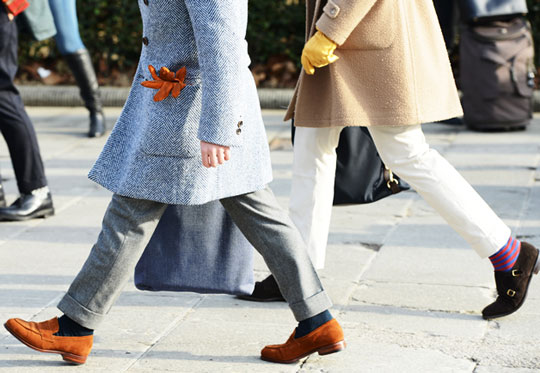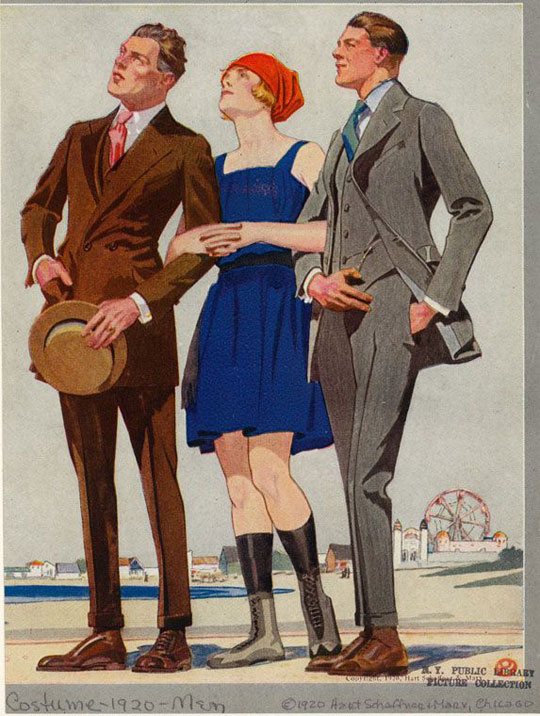I’ve been meaning to run a series taking a closer look at trousers for some time and given that my last couple of columns have been quite political, I thought that it would be prudent to return to the business of dressing itself. I have a particular interest in trousers at the moment, not only because I’m finding it increasingly difficult to find trousers that I’m prepared to wear off-the-peg, (you can read about the ongoing trouser crisis on my blog) but also because simultaneously, I’ve realised that the modern trouser gets a rather bad-deal.
Think about it for a moment, what is the kind of trouser that the high street uniformly produces? It features a low to mid-rise often on a par with jeans, (meaning that it sits low on the hips), predominantly with belt loops, a leg that is cut by necessity to accommodate all leg shapes (i.e. baggy), with a flat-front and without turn-ups, waist adjusters or brace buttons. Pleats, and different pocket shapes don’t even come into the equation. In this series of pieces, I’ll be taking a look the history of the trouser and exploring the richly diverse variety of cuts and styles available to those who are prepared to be a little more adventurous. In other words, these pieces intend for you to get trousers working in your favour, suiting your style and figure.
The turn-up, believe it or not, sports a rich and illustrious history. Their inventor, and initial pioneer, was King Edward VII. The story is simple, Edward, ever the dandy and style icon of his era, used to roll-up his trouser legs (as did many men) during bad weather, to prevent the trouser hems from becoming damp or muddied. King Edward simply made the decision at some point around the turn of the 20th century, to have the feature tailored into his trousers. Being the international style icon of his day, the icon caught on and remained a popular choice (with the exclusion of the war years, where turn-ups, along with broad lapels and pocket flaps, were made illegal in Britain, to conserve wool) right up until the 1960s, when super-slim, minimalistic mod-suiting put an end to dressy or chunky features such as the turn-up. Since then, the turn-up has drifted in and out of fashion driven more or less by personal choice, as they continue to today.
So, turn-ups (or cuffs if you prefer), why bother with them? There are a number of reasons. Firstly, cuffs are undergoing a serious renaissance at the moment, and many high-end menswear brands and tailors are leaving trousers un-hemmed and encouraging customers to wear turn-ups; they’re close to knocking the plain trouser hem off the top stop as the most common type of trouser finish. The reason that tailors and designers are so keen on turn-ups, is because contrary to popular belief, turn-ups really can flatter any figure. Turn-ups do not shorten the leg, or unbalance the silhouette of the leg, if they’re done right.
Turn-ups should ideally be used to add more shape to the trouser and provide a focus for the bottom of the leg. My own trousers provide the perfect example; I have rather chunky thighs, and therefore use turn-ups to add some body to the bottom of my trousers, and detract from the imbalance of shape between my upper and lower legs.
The fact that turn-ups can add body to the lower trouser, means that if anything, they give the impression of lengthening the leg as opposed to shortening it, so long as the trouser is fitted to the natural tapering of the wearer’s thigh and calf.Take note that I do not mean that your trouser should be too slim or tight, but it should sit comfortably around your upper and lower legs and mirror the natural taper of your legs from thigh to calf. Equally helpful is the extra weight that turn-ups provide at the bottom of the trouser, which actively helps the trouser leg to fall and drape down the leg with a natural shape (particularly if the trouser creases run down from trouser pleats, and incidentally, I’d always recommend wearing turn-ups with pleats, for the same reason quoted above; on a trouser with lots of body at the top, it needs a focal point at the bottom too).
Turn-ups also work well on trousers with a fuller drape, but a full cut trouser leg with turn-ups is just about the only shape that won’t suit a shorter leg. My final major bugbear with turn-ups is that they’re too often seen on trouser legs which are too long. Turn-ups look their best when worn with no break to the trouser, sitting in a neat horizontal line just resting on the top of the shoe. This is how they were worn traditionally when they were popularised in the 20s, as you can see from the photograph I’ve chosen, and its by far and away, the cleanest way to wear them.
With this in mind, one thing to consider is the thickness of the turn-up and there are two elements that I’d recommend you keep in mind when deciding this. Firstly, is the chunkiness of the jacket you’re wearing; if you’re wearing something with broad lapels or deep pocket flaps (or even a particularly boxy skirt) slim turn-ups will look too delicate. The second consideration is the length of your leg; a particularly chunky 2 or 2.5 inch turn-up will suit a tall man, or a man with long legs, but this will make the smaller man look even more so, so is to be avoided. I would advise that gentlemen with shorter legs opt for a 1.25 to 1.5 inch thickness of turn-up as opposed to anything thicker. If you can master these few simple recommendations, you’ll soon discover that there’s no trouser (or figure) that the turn-up can’t work on – I hope you enjoy experimenting!




No comments:
Post a Comment